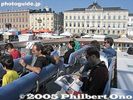
Ferry to Suomenlinna Sea Fortress スオメンリンナへのフェリーA boat for Suomenlinna departs often from the market place at the waterfront. Only 15-min. ride. Suomenlinna is a sea fortress designated as a World Heritage Site and Helsinki's biggest tourist attraction.
スオメンリンナは、ヘルシンキ沖にある島で中世の城塞。このフェリーで15分。
HP: スオメンリンナ要塞(日本語)
|
|
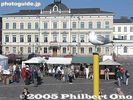
Helsinki waterfront market place and seagull マーケット広場The waterfront and market square is one of the city's most picturesque areas.
ヘルシンキ市内の一番美しいところ。
|
|
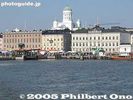
Helsinki waterfront from ferryThe Cathedral floats nicely above the waterfront buildings. Now I understand why it was built on a hill and painted white.
白い大聖堂も浮かぶように見える。
|
|
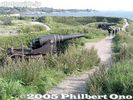
Suomenlinna fortress スオメンリンナComprising several small islands, Suomenlinna was a sea fortress originally built in 1748 by the Swedish empire (when Finland was part of Sweden) to fend off attack by Russia in the east.
Today, it is Helsinki's biggest tourist attraction. Besides being a World Heritage Site, it is a pleasant island for picnics (in warmer months) and picture-taking. It's quite big, so you cannot see everything on a day trip.
The fortress has museums, restaurants, and over 100 old cannons and guns still remaining.
Web site: suomenlinna.fi
Another: Virtual Finland
世界遺産でもあるスオメンリンナは、ヘルシンキ沖にある島で中世の城塞。ヘルシンキの最大の観光目玉。スオメンリンナはまだ100本以上の大砲が残っている。
HP: スオメンリンナ要塞(日本語)
|
|
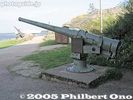
Japanese gun at Suomenlinna 明治時代の日本海軍の大砲We were surprised to hear that Suomenlinna had a cannon from Japan. The Suomenlinna Visitor Center had a map in English called "The Guns of Suomenlinna" with all the cannons and guns listed (over 100), including the Japanese gun.
However, there was no explanation of the Japanese gun, and no one at the Visitor Center knew the history behind the Japanese gun. And I could not find any books in the Visitor Center gift shop that explained about the gun, like how in the world it got to Finland and Suomenlinna from faraway Japan.
But after returning to Japan, I did some reading and found out interesting things about it. On the Web, I found a few Japanese sites (but none in English) that mention this gun, and I found only one Web site with a picture of the gun. So I'm happy to show better pictures of the gun as well as an explanation in English.
This is what I found out so far:
The gun was made at Kure Naval Arsenal in Hiroshima Prefecture in 1898. (This can be confirmed by the inscription on the gun.) Kure was a major navy base.
After the Russo-Japanese War in 1904-05, Japan exported this gun to Russia. Before World War I broke out in 1914, Russia placed this 120mm-caliber gun on the coast to help defend the Gulf of Finland and St. Petersburg (or Petrograd as it was known during WWI) from possible attack by Germany. (Finland during this time was part of the Russian empire.)
After the Russian Bolshevik Revolution of 1917, Finland seized the opportunity and declared itself as an independent country which was approved by Russia. It thereby inherited this Japanese gun positioned in the former Russian territory now under Finnish control. For coastal defense, Finland used this gun as left by the Russians.
On Nov. 30, 1939, the Soviet Union attacked Finland with the intent to conquer it by the end of the year and make it a buffer state against hostile Nazi Germany. This started the Winter War with Finland which lasted until March 1940.
Although Finland's forces were greatly outnumbered by the Soviets, their guerrilla tactics and the severe winter inflicted heavy Soviet casualties. One major battlefront was near a small Finnish town called Taipale on the northwestern shore of Lake Ladoga near St. Petersburg. Taipale had two Finnish batteries, one of which was at Järisevä on the lakeshore, where the Japanese gun was stationed. (I'm not sure how the gun got to Taipale, whether the Russians had put it there from the beginning or whether the Finns moved it there from Finland's coast.)
Taipale was not too far from the border with the Soviet Union and was at the mouth of a small river called Taipaleenjoki. By Dec. 6, the Soviets from the southwest advanced far enough to reach the river on the side opposite of Taipale. What looked to be a piece of cake for the Soviets turned out to be a bloody battle lasting 3 months. The Finns proved to be ferocious fighters.
By Feb. 19, 1940, the Soviets finally started to make headway into the Finnish line of defense, called the Mannerheim Line that partially straddled along the Taipaleenjoki River, with heavy air and ground attacks. It was also the day when they attacked Taipale from both the east and west.
The west flank faced the ice on Lake Lagoda over which the Soviets marched, only to meet with artillery fire from the Järisevä battery on the lake shore. With the help of the damaged Japanese gun, the Finns destroyed two Soviet tanks and kept firing until they ran out of ammunition. The Soviet attack on Taipale from the west thus ended in failure, and the attack from the eastern flank was also futile. The lake ice was littered with dead Soviet soldiers. At the end of the war, the Finns carried their beloved Japanese gun back to Finnish territory even though it was damaged beyond repair.
Although Taipale never fell to the Soviets during battle, Finland was forced to cede the town and the entire region around northern Lake Ladoga (plus some territory in northeast Finland) to the Soviets in accordance with the Moscow Peace Treaty that ended the Winter War on March 12, 1940. These concessions understandably upset many Finns. Thousands of Finnish lives had been lost fighting for territory that was later handed over to the Soviets in peace. The ceded area was also Finland's industrial center and cradle of Finnish (Karelian) culture. The peace lasted only for about a year until both countries again fought each other during the Continuation War during June 1941 to September 1944.
Here's a little more background info about the gun researched by my friend Ronny Rönnqvist and edited by me:
Specifications
The gun is a derivative of the British 4.7 inch/40 (120mm/12cm) Amstrong-Elswick Naval/Coastal Gun, developed in the 1880s. The gun was manufactured under license in Japan by the Kure Naval Arsenal and used on Japanese cruisers of the late 1800s / early 1900s and later as a coastal defence gun.
In Japan the gun is known as Meiji 31st Year Type (120/41A) Kaigun Ho. (As inscribed on the gun in Japanese.) Some guns might have been taken by the Russians already during the Russo-Japanese war, but Japan also later on sold a quantity of these guns to Russia.
History
This particular gun in Suomenlinna is very famous in Finland. It belonged to 8 guns of this type left by the Russian Army in Finland after the War of liberation in 1917-18 when Finland won its independence. These guns were then used as coastal defence guns in various locations.
During the final days of the Winter War in 1940, the Fort of Järisevä in the Finnish town of Taipale on the western shore of Lake Ladoga (now in Russian territory near St. Petersburg) was defended by two such guns. In February only this gun was working when a Russian batallion approached over the lake ice on Feb. 19, 1940.
The gun had been hit and damaged (see the crack on the side of the barrel), but could be barely repaired in time in order to fire at the approaching enemy. By direct aiming and firing the gun with a hammer and although the barrel was badly damaged, the crew succeeded in hitting the tank leading the attack by the 6th shot. Thereby the Russian battalion withdrew and Taipale was saved.
The gun therefore became very famous and was taken to Finland and eventually moved to Suomenlinna to have a place of honour in front of the Coastal Artillery Museum where it is located today.
There were many more Japanese guns used by Finland, all left by the Russian Army in 1918:
- 75 mm mountain gun type 75 VK 98
- light 47mm coastal gun type 47/30
- heavy 150 mm hoowitzer type 150H 14 J ( J for Japan ! )
- a large quantity of Arisaka rifles
But none got as famous as this gun at Suomenlinna!
スオメンリンナには、なんと明治時代の日本海軍の大砲も設置してありました。日本からロシアへ輸出されたそうです。そしてロシアから独立国になって大砲がそのままフィンランドのものになった。
1939-40年のソ連との冬戦争中にラゴダ湖岸にあるタイパレ村にフィンランド軍がこの痛んだ大砲でソ連の部隊に発砲して一台の戦車を大破してソ連の攻撃が失敗に終わった。これで一躍有名になった大砲がスオメンリンナの栄誉な場所に移動された。ロシアから譲った他の日本製の砲もあったそうですが、この砲が一番歴史的で有名。
|
|
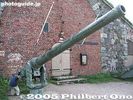
Japanese gun at Suomenlinna 日本海軍製の大砲Right view of gun where you can see the cracked barrel.
|
|
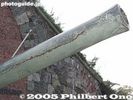
Closeup of cracked barrel 割れた砲
|
|

Maker's inscription on Japanese gun 大砲の日本語表示It says the gun was made by Kure Naval Arsenal in the 31st year of the Meiji Period (1898). Kure was a large naval base in Hiroshima Prefecture.
砲尾の上に「呉海軍造兵廠、明治参拾壱年」 が刻まれていた。
|
|

Serial No. on Japanese gunThis looks like a serial No. for this gun. It reads 2143.
砲の製造番号と思われる「弐千百四拾参基」と刻んでいる。
|
|

Valiant service of Japanese gunThis plaque next to the gun describes how it fired its last shot during the Winter War on Feb. 19, 1940 despite being badly damaged. It destroyed a Russian tank and thus repelled a Russian battalion.
Taipale was a small Finnish town on the northwestern shore of Lake Ladoga which is now part of Russia. It was one of Finland's front-line defenses against the advancing Soviet army. Although Taipale never fell to the Russians, it was later ceded to Russia along with the entire surrounding area in accordance with a peace treaty.
|
|
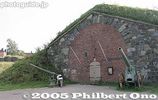
Japanese gun on left 沿岸砲兵博物館にてThe gun is in front of the Coastal Artillery Museum at Suomenlinna. You can find it on the "Guns of Suomenlinna" map available free at the Visitor Center.
左が元日本海軍の大砲。沿岸砲兵博物館の前にある。スオメンリンナの観光案内所で大砲の地図がある。それを見ればこの日本の砲も見つけられる。
|
|

Inside a fortress building 中の石垣The fortress has a lot of nice stonework still intact.
スオメンリンナは、まだ石垣がたくさん残っている。
|
|











